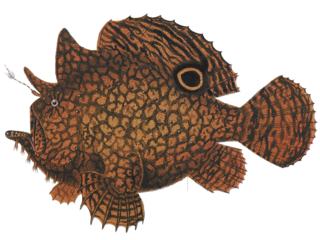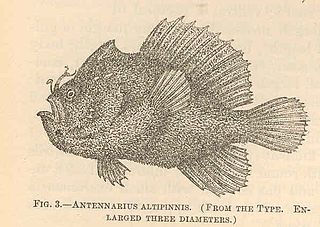
The spotfin frogfish, also known as the big-spot angler, coin-bearing frogfish, darkspot frogfish, ocellated angler, ocellated fringed fishing frog, opulent frogfish, spotfin angler or white-finger anglerfish, is a species ray-finned fish belonging to the family Antennariidae, the frogfishes. The spotfin frogfish is found in scattered locations the eastern Atlantic, Indian and western Pacific Oceans.

The striated frogfish or hairy frogfish is a species of marine ray-finned fish belonging to the family Antennariidae, the frogfishes. This species is found in the Indo-Pacific and eastern Atlantic Ocean.

Commerson's frogfish or the giant frogfish, Antennarius commerson,, is a species of euryhaline ray-finned fish belonging to the family Antennariidae, the frogfishes. This fish is found in the Indo-Pacific region.

Histiophryne is a genus of frogfishes found in waters ranging from Taiwan to South Australia. There are currently five known species. These fishes are easily distinguished from other anglerfishes as having a reduced luring appendage, a highly evolved form of the first dorsal fin spine.

Antennarius is a genus marine ray-finned fishes belonging to the family Antennariidae, the frogfishes. The fishes in this genus are found in warmer parts of the Atlantic, Indian and Pacific Oceans.

Antennatus is a genus of marine ray-finned fishes belonging to the family Antennariidae, the frogfishes. The fishes in this genus are found the Indian and Pacific Oceans.

The shaggy frogfish, also known as the hispid frogfish, shaggy anglerfish or zebra anglerfish, is a marine ray-finned fish belonging to the family Antennariidae, the frogfishes. This fish is found in the Indo-Pacific.

The painted frogfish, or spotted frogfish, black angler or painted anglerfish is a species of marine ray-finned fish belonging to the family Antennariidae, the frogfishes. This species is found in the Indo-Pacific region.

Abantennarius sanguineus, the bloody frogfish or sanguine frogfish, is a species of marine ray-finned fish belonging to the family Antennariidae, the frogfishes. The sanguine frogfish is found in the eastern Pacific Ocean.

Randall's frogfish is a species of marine ray-finned fish belonging to the family Antennariidae, the frogfishes. This species is found in the Indo-Pacific region.
Abantennarius drombus, freckled frogfish or Hawaiian freckled frogfish, is a species of marine ray-finned fish belonging to the family Antennariidae, the frogfishes. The freckled frogfish is endemic to the Hawaiian Islands.

Antennarius biocellatus, the brackish water frogfish, brackish water anglerfish, freshwater frogfishtwinspot frogfish or fishing frog, is a species of euryhaline ray-finned fish belonging to the family Antennariidae, the frogfishes. This fish is found in the Western Pacific Ocean.

Antennarius indicus, the Indian frogfish, is a species of marine ray-finned fish belonging to the family Antennariidae, the frogfishes. The Indian frogfish is found in the Indian Ocean.

Antennarius pardalis, the leopard frogfish or peixe pescador, is a species of marine ray-finned fish belonging to the family Antennariidae, the frogfishes. This species is found in the eastern Atlantic Ocean.
Abantennarius analis, the tailjet frogfish, tailjet anglerfish or dwarf frogfish, is a species of marine ray-finned fish belonging to the family Antennariidae, the frogfishes. This species is found in the eastern Indian Ocean and the western Pacific Ocean.
Abantennarius bermudensis, the island frogfish, is a species of marine ray-finned fish belonging to the family Antennariidae, the frogfishes. The island frogfish is found in the Western Atlantic Ocean.

Abantennarius dorehensis, the New Guinean frogfish, bandtail frogfish, Dorei frogfish or white-spotted frogfish, is a species of marine ray-finned fish belonging to the family Antennariidae, the frogfishes. The New Guinean frogfish is found in the Indo-Pacific region.
Antennatus strigatus, the bandtail frogfish, is a species of marine ray-finned fish belonging to the family Antennariidae, the frog fishes. This species is found in the eastern Pacific Ocean.

Abantennarius is a genus of marine ray-finned fishes belonging to the family Antennariidae, the frogfishes. The fishes in the genus are found in the Indian, Pacific and, one species, in the Western Atlantic Oceans.

Antennarius scaber, the splitlure frogfish or strated frogfish, is a species of marine ray-finned fish belonging to the family Antennariidae, the frogfishes. This species is found in the Western Atlantic Ocean and was previously considered to be a synonym of Antennarius striatus.

















